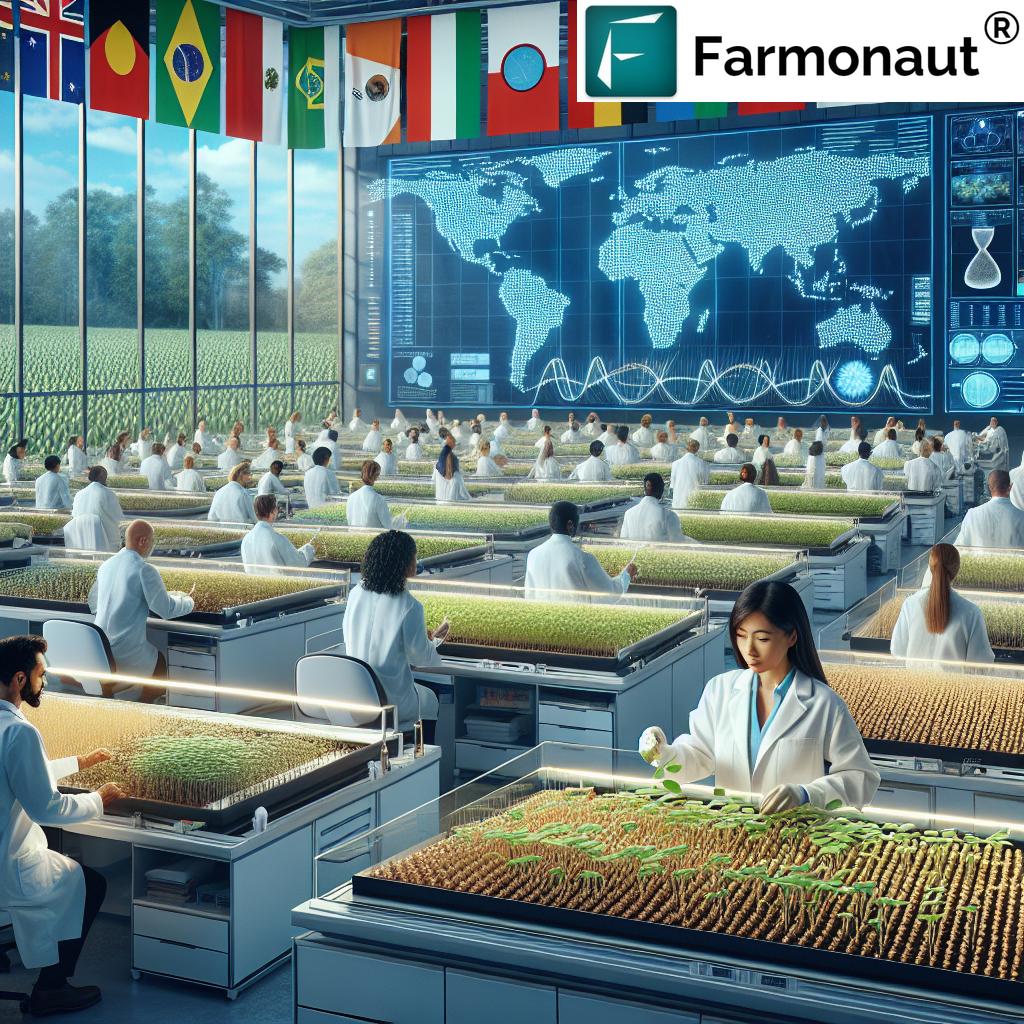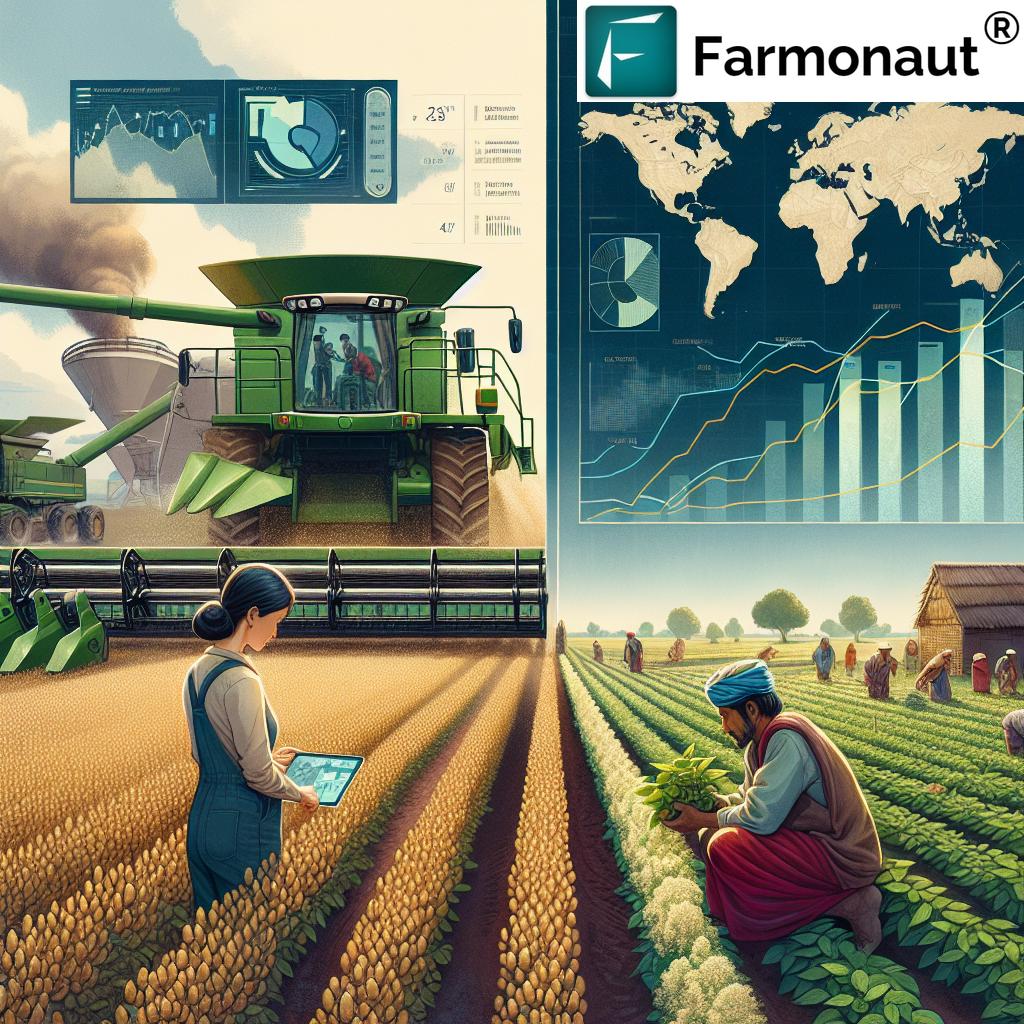USAID Cuts Threaten Global Food Security: How Soybean Innovation in Illinois Impacts International Development
“USAID funding cuts impact over 50 countries, affecting millions relying on agricultural development programs.”
“Soybean innovation research in Illinois contributes to food security for an estimated 500 million people globally.”
In an unprecedented move that has sent shockwaves through the global agricultural community, recent cuts to the United States Agency for International Development (USAID) funding have placed critical soybean innovation research and international agricultural development initiatives in jeopardy. As we delve into this complex issue, we’ll explore how these policy changes are affecting American businesses, farmers, and nonprofits engaged in humanitarian aid programs, with a particular focus on the groundbreaking work being done at the University of Illinois Soybean Innovation Lab.
The Far-Reaching Impact of USAID Funding Cuts
The abrupt decision to freeze foreign assistance has created a ripple effect that extends far beyond Washington D.C. From crop innovation labs facing closure to refugee missions imperiled, the human stories behind this policy shift are both compelling and concerning. As we examine the interconnected nature of U.S. foreign aid, trade, and humanitarian efforts, it becomes clear that the consequences of creating a vacuum in foreign assistance could have significant implications for global stability.

Soybean Innovation Research: A Cornerstone of International Agricultural Development
At the heart of this issue lies the University of Illinois Soybean Innovation Lab, a beacon of agricultural progress that has been instrumental in expanding soybean usage across 31 countries. This lab, which collaborates with processors, food manufacturers, and seed and fertilizer companies, is now facing an uncertain future due to the USAID funding freeze.
Dr. Peter Goldsmith, director and principal investigator at the Soybean Innovation Lab, emphasizes the lab’s role in opening international markets to U.S. farmers and making soybeans more prevalent in Africa. “Our work has been crucial in building steady partnerships based on trade and U.S. foreign aid,” Goldsmith explains. “This approach has proven to be the most effective way to wield U.S. influence and promote global food security.”
The Domino Effect: From Illinois to International Food Security
The potential closure of the Soybean Innovation Lab is not an isolated incident. Similar crop innovation labs at other land grant universities across the United States are also facing shutdown. This widespread disruption in agricultural research and development poses a significant threat to global food security initiatives.
Goldsmith expresses deep concern about the vacuum that will be created in the countries where these labs have been working. “What will fill that vacuum?” he ponders. “It will be filled. There’s no doubt about it. But by whom, and with what consequences?”
The Human Cost: Refugee Missions and Humanitarian Aid at Risk
Beyond the agricultural sector, the USAID funding cuts are having a devastating impact on nonprofits working to stabilize populations and economies abroad. One such organization feeling the strain is HIAS, a Jewish group aiding refugees and potential refugees, which is now facing the closure of “almost all” of its more than 120-year-old mission.
HIAS President Mark Hetfield describes the situation as dire. “The administration calls it a ‘suspension,’ rather than a termination,” he says. “But we have to stop paying our leases, stop paying our employees. It’s not a suspension. That’s a lie.”
Data-Driven Development: The Unsung Heroes of USAID Effectiveness
In the realm of international development, data is king. Organizations like Causal Design, a small Denver-area nonprofit led by Marine veteran Keith Ives, have been instrumental in testing the effectiveness of USAID programs through rigorous data analysis.
Ives’ team has conducted crucial research, such as measuring the impact of USAID support on children’s health in Ethiopia. However, with 70% of their work coming from USAID, Causal Design is now facing significant layoffs and an uncertain future.
“At first, it was an obsession over how can I fix this,” Ives recalls. “There must be a magic formula… I’m just not thinking hard enough, right?” The reality, however, is far more complex and concerning.
The Ripple Effect on American Businesses and Supply Chains
The impact of the USAID funding freeze extends beyond research labs and humanitarian organizations. U.S. companies involved in the supply chain of USAID-funded projects are also facing severe challenges. These businesses, which have developed expertise in delivering food and goods to remote and often poorly regulated regions, are now grappling with financial ruin.
An executive from one such supply-chain business, speaking anonymously due to fears of reprisal, describes the heart-wrenching process of laying off hundreds of workers. “It’s devastating,” the executive says, voice breaking. “These are skilled professionals who have dedicated their careers to supporting global development efforts.”
American Farmers: Caught in the Crossfire
For American farmers, particularly those involved in soybean production, the USAID funding cuts represent a potential loss of market share and a disruption to long-standing humanitarian efforts. Tom Waters, a seventh-generation farmer from Missouri, reflects on the wisdom passed down through his family: “People get hungry, they’ll fight.”
Waters understands that feeding people abroad is how American farmers contribute to global stability. “We’re helping them keep people’s bellies full,” he explains. This perspective underscores the critical role that U.S. agricultural exports play in international food security initiatives.

The Role of Technology in Mitigating the Crisis
As the agricultural sector grapples with these challenges, innovative technologies are emerging as potential solutions to help farmers and researchers navigate this uncertain landscape. Platforms like Farmonaut are at the forefront of this technological revolution, offering advanced, satellite-based farm management solutions that can help optimize crop yields and resource management.
While these tools cannot replace the vital role of USAID funding, they can provide valuable support to farmers and researchers looking to maximize efficiency and productivity in the face of reduced international aid. By leveraging satellite imagery, AI, and machine learning, these platforms offer real-time insights into crop health, soil moisture levels, and other critical metrics that can inform decision-making and potentially mitigate some of the impacts of funding cuts.
International Market Expansion for Soybeans: A Balancing Act
The USAID funding cuts not only affect humanitarian efforts but also have implications for international market expansion for U.S. soybean exports. The Soybean Innovation Lab at the University of Illinois has been instrumental in opening new markets for American farmers, particularly in Africa. With the potential closure of this lab and others like it, there’s a risk that these carefully cultivated market opportunities may be lost.
Dr. Brian Diers, Professor Emeritus of Crop Science and deputy director of the Soybean Innovation Lab, emphasizes the importance of continued research and development in maintaining U.S. competitiveness in the global soybean market. “Our work doesn’t just benefit farmers in developing countries,” Diers explains. “It also creates new opportunities for U.S. soybean exports and helps maintain our position as a global leader in agricultural innovation.”
The Future of Global Food Security Initiatives
As we look to the future, the impact of these USAID funding cuts on global food security initiatives remains uncertain. The potential loss of crucial research, development, and humanitarian programs could create significant challenges in addressing hunger and malnutrition worldwide.
However, the resilience of the agricultural community and the ongoing advancements in agricultural technology offer some hope. Innovative solutions, such as those provided by platforms like Farmonaut, may help bridge some of the gaps left by reduced funding. These tools can assist farmers in optimizing their crop production, potentially offsetting some of the impacts of decreased international aid.
“USAID funding cuts impact over 50 countries, affecting millions relying on agricultural development programs.”
“Soybean innovation research in Illinois contributes to food security for an estimated 500 million people globally.”
The Path Forward: Collaboration and Innovation
In the face of these challenges, collaboration between researchers, farmers, and technology providers will be crucial. By combining the expertise of agricultural scientists with cutting-edge technology and the practical knowledge of farmers, we can work towards maintaining and even advancing global food security efforts.
For instance, the integration of satellite-based crop monitoring systems, like those offered by Farmonaut, with ongoing agricultural research could provide valuable data to inform future development initiatives. This synergy between traditional agricultural research and modern technology may offer new pathways for addressing food security challenges in a resource-constrained environment.
Impact of USAID Funding Cuts on Soybean Innovation and Global Food Security
| Sector Affected | Pre-Cut Status | Post-Cut Projections | Potential Global Consequences |
|---|---|---|---|
| Soybean Research Funding | $10 million annual budget | 80% reduction in funding | Decreased crop innovation, potential loss of market share |
| Agricultural Development Programs | Active in 31 countries | Programs suspended in 25 countries | Reduced food security, increased risk of hunger |
| Refugee Aid Missions | Supporting 2 million refugees | 60% reduction in aid capacity | Increased displacement, potential humanitarian crisis |
| U.S. Soybean Exports | $22 billion annual exports | Projected 15% decrease | Economic impact on U.S. farmers, potential market loss to competitors |
The Role of Precision Agriculture in Mitigating Funding Cuts
As traditional funding sources face uncertainty, the role of precision agriculture becomes increasingly important. Advanced technologies, such as those offered by Farmonaut, can help farmers and researchers maximize efficiency and productivity, potentially offsetting some of the impacts of reduced international aid.
Farmonaut’s satellite-based crop health monitoring system, for instance, provides valuable insights into vegetation health, soil moisture levels, and other critical metrics. This data-driven approach to farming can help optimize resource use, reduce waste, and potentially increase crop yields – all crucial factors in maintaining food security in the face of funding challenges.
Leveraging Technology for Agricultural Research
While advanced agricultural technologies cannot replace the vital role of USAID funding, they can provide valuable support to researchers and farmers. The integration of AI-driven advisory systems, like Farmonaut’s Jeevn AI, with ongoing agricultural research could offer new pathways for addressing food security challenges in a resource-constrained environment.
These AI systems can analyze vast amounts of data from satellite imagery, weather forecasts, and historical crop performance to generate customized advice for farmers. This technology-driven approach could help maintain the momentum of agricultural innovation, even as traditional research funding faces cuts.
The Global Implications of Local Innovation
The work being done at the University of Illinois Soybean Innovation Lab exemplifies how local research can have far-reaching global impacts. By developing new soybean varieties and cultivation techniques, this lab has been instrumental in improving food security for millions of people worldwide.
The potential loss of such innovation hubs due to funding cuts could have ripple effects across the global food system. It underscores the need for continued investment in agricultural research and development, as well as the adoption of innovative technologies that can help stretch limited resources further.
The Future of International Agricultural Development
As we navigate this challenging landscape, it’s clear that the future of international agricultural development will require a multifaceted approach. This may involve a combination of:
- Continued advocacy for the reinstatement of USAID funding
- Increased collaboration between research institutions, technology providers, and farmers
- Greater adoption of precision agriculture technologies to maximize efficiency
- Exploration of alternative funding sources for critical research and development projects
By leveraging the power of innovation, data, and collaboration, we can work towards maintaining and even advancing global food security efforts, despite the current funding challenges.
Conclusion: A Call to Action
The USAID funding cuts present a significant challenge to global food security and international agricultural development. From the potential closure of crucial research labs like the Soybean Innovation Lab at the University of Illinois to the disruption of humanitarian aid programs, the impacts are far-reaching and profound.
However, this crisis also presents an opportunity for innovation and collaboration. By embracing advanced agricultural technologies, fostering partnerships between researchers and technology providers, and continuing to advocate for the importance of international aid, we can work towards mitigating the impacts of these funding cuts.
As we move forward, it’s crucial that we recognize the interconnected nature of global food security, international development, and agricultural innovation. By supporting initiatives that promote sustainable farming practices, leverage cutting-edge technology, and foster international cooperation, we can help ensure a more food-secure future for all.
FAQ Section
- How do USAID funding cuts affect global food security?
USAID funding cuts significantly impact global food security by reducing support for crucial agricultural research, development programs, and humanitarian aid efforts. This can lead to decreased crop innovation, reduced food availability in vulnerable regions, and potential market losses for U.S. farmers. - What is the role of the Soybean Innovation Lab at the University of Illinois?
The Soybean Innovation Lab conducts critical research to improve soybean cultivation techniques and develop new varieties. Its work has been instrumental in expanding soybean usage across 31 countries, contributing to global food security and opening international markets for U.S. farmers. - How can precision agriculture technologies help mitigate the impact of funding cuts?
Precision agriculture technologies, such as satellite-based crop monitoring and AI-driven advisory systems, can help farmers optimize resource use, reduce waste, and potentially increase crop yields. This can partially offset the impacts of reduced international aid by improving agricultural efficiency and productivity. - What are the potential long-term consequences of these funding cuts?
Long-term consequences may include reduced global food security, increased risk of hunger and displacement in vulnerable regions, potential loss of market share for U.S. agricultural exports, and a slowdown in agricultural innovation and development. - How can individuals and organizations support global food security efforts in light of these challenges?
Individuals and organizations can support global food security efforts by advocating for the reinstatement of USAID funding, supporting research institutions and humanitarian organizations, adopting and promoting sustainable farming practices, and leveraging innovative agricultural technologies to improve efficiency and productivity.
Support Sustainable Agriculture with Farmonaut
As we navigate these challenging times for global food security, innovative solutions like Farmonaut are more important than ever. Farmonaut offers advanced, satellite-based farm management solutions that can help farmers optimize their crop production and resource management, potentially mitigating some of the impacts of reduced international aid.
By leveraging cutting-edge technology, Farmonaut empowers farmers to make data-driven decisions, improve crop yields, and contribute to more sustainable agricultural practices. While it cannot replace the crucial role of USAID funding, it offers valuable tools for farmers and researchers looking to maximize efficiency and productivity in the face of global challenges.
Explore Farmonaut’s solutions and see how you can contribute to more sustainable and efficient farming practices:
For developers interested in integrating Farmonaut’s powerful satellite and weather data into their own systems, explore our API:
Earn With Farmonaut
Earn 20% recurring commission with Farmonaut’s affiliate program by sharing your promo code and helping farmers save 10%. Onboard 10 Elite farmers monthly to earn a minimum of $148,000 annually—start now and grow your income!
Learn More About Our Affiliate Program
Subscribe to Farmonaut
By leveraging innovative solutions like Farmonaut and continuing to support crucial agricultural research and development, we can work together to address the challenges posed by USAID funding cuts and contribute to a more food-secure future for all.







